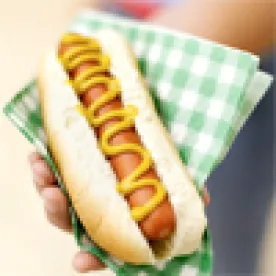On May 10, 2016, Judge Joseph F. Leeson, Jr. of the Eastern District of Pennsylvania granted summary judgment on false advertising and trademark claims in favor of defendant Tyson Foods, Inc. and a subsidiary, the makers of “Park’s Finest” frankfurters. The decision illustrates important distinctions between two causes of action—trademark infringement and false advertising—both covered by the same section of the same statute, the Lanham Act.
Defendants launched the “Park’s Finest” brand of super-premium frankfurters in February 2014, and according to marketing reports produced in discovery, that name was chosen to evoke an association with defendants’ existing “Ball Park”-brand beef hot dogs.
However, Plaintiff Parks, LLC, the owner of the “Parks” mark for sausages and other food products, took umbrage, and brought a Lanham Act suit against defendants that alleged both false advertising and trademark claims. According to plaintiff, the name of defendants’ product, “Park’s Finest,” was a literally false statement that misrepresented defendants’ products as products of plaintiff.
In granting defendants’ summary judgment motion in its entirety, the court found that plaintiff was barking up the wrong tree. The court began by explaining the difference between trademark infringement claims and false advertising claims. Section 43(a) of the Lanham Act (codified at 15 U.S.C. § 1125(a)), prohibits “two major and distinct types” of conduct: false association and false advertising. As the court explained, the prohibition on false association is implicated where a misrepresentation is likely to cause confusion as to the “affiliation, connection, or association of [a] person with another person, or as to the origin, sponsorship, or approval of his goods, services, or commercial activities by the person.” 15 U.S.C. § 1125(a)(1)(A). The analytical framework for assessing false association claims is trademark law. By contrast, the prohibition on false advertising is implicated when advertising or promotional activities misrepresent the “nature, characteristics, qualities, or geographic origin of [a person’s] goods, services, or commercial activities.” 15 U.S.C. § 1125(a)(1)(B).
The court observed that plaintiff’s so-called “false advertising” allegations—i.e., that the name “Park’s Finest” misrepresented defendants’ products to be plaintiff’s products—did not actually relate to the “nature, characteristics, qualities, or geographic origin” of the Park’s Finest products. Instead, defendants’ use of the name “Park’s Finest” could deceive consumers only if it led them to believe that the product was associated with plaintiff Parks. As such, Plaintiff’s allegations regarding defendants’ product name amounted to allegations of “false association,” not “false advertising,” and therefore the proper analytical framework was trademark law, not false advertising law.
In all events, the court concluded that plaintiff’s claim failed under a false advertising analysis. The court found that the product name “Park’s Finest” was not a literally false statement because literally false messages must be unambiguous, and the name “Park’s Finest” did not unambiguously refer to plaintiff’s mark. Nor, the court found, could plaintiff make out a claim for impliedly false advertising because its consumer survey was flawed in three main respects, all of which stemmed from plaintiff’s effort to use the survey to pull “double-duty” to support both the false advertising and trademark claim.
First, the survey failed to ask participants about the message they received from the product and its packaging, and about the meaning of that message. Under Third Circuit law, a well-designed false advertising survey, once past the basic open ended questions, first asks “communication” questions to ascertain what messages the participant received and to “filter” or separate participants who received certain messages from those who did not. A good survey then asks “comprehension” questions to determine what participants thought the message meant. The court found that plaintiff’s survey assessed whether consumers who simultaneously encounter the Park’s Finest and Parks breakfast sausage packages would be confused about their relationship to each other, but the survey failed to use “communication” questions, a “filter” and “comprehension” questions pertaining to the messages conveyed by Park’s Finest packaging on its own. Thus, the court held that although the survey may be “appropriate to assess the likelihood of confusion in connection with a trademark infringement claim,” it lacked the “appropriate methodology” to assess a false advertising claim.
The second flaw concerned “secondary meaning.” To support its purported “false advertising” claim, plaintiff would have had to show (1) that consumers associated “Parks” with plaintiff Parks, and (2) that consumers would also mistakenly associate defendants’ “Park’s Finest” name with plaintiff Parks. The survey skipped the first step, inappropriately assuming that participants would associate “Parks” with the plaintiff.
Finally, the survey’s universe was inadequate. The population surveyed was limited to participants living in ZIP codes where plaintiff’s “Parks”-branded products were sold. The appropriate survey population, however, was the broader intended audience for defendants’ Park’s Finest products.
For these reasons, the court granted defendants summary judgment on plaintiff’s false advertising claim. It also granted defendants summary judgment on plaintiff’s trademark claim, in part because plaintiff had not shown that “Parks” had secondary meaning for the relevant population, which was a necessary part of its trademark infringement claim.





 />i
/>i
